Moving and handling the child with suspected/diagnosed spinal injury: log rolling, Standard Operating Procedure
exp date isn't null, but text field is
Objectives
- To provide a consistent approach to the moving and handling of children with suspected/diagnosed spinal injuries within PICU.
- To prevent spinal cord injury and/or ascension of injury.
- To facilitate procedures.
- To facilitate assessment of the patient’s dorsal surfaces and prevent the development of pressure sores
- To minimise manual handling risks
Scope
This guideline is intended for all healthcare professionals caring for children with suspected/diagnosed spinal injury within the Paediatric Critical Care Unit at the Royal Hospital for Children, Glasgow.
Audience
This guideline is designed as a learning aid, not as a substitute for training. All medical, nursing and allied health professionals caring for patients who have suspected/proven spinal injury should be familiar with this standard operating procedure.
Within PICU, this standard operating procedure should be considered for any child with a suspected or proven spinal injury regardless of level of consciousness. Prior to and throughout this procedure, the nurse should ensure that clear explanation and reassurance is offered to the child and parents, where present.
Cervical spine injuries should be suspected in all children admitted to the paediatric critical care unit with:
- Significant accident history- sudden impact, collision, deceleration, fall from height or ejected from vehicle.
- Severe head injury i.e Glasgow Coma score (GCS) of 8 or less
- Trauma to vertebral column
- Neurological symptoms of spinal cord injury
- Injuries above the clavicle
- Altered level of consciousness after trauma
- Cervical spine surgery
N.B. Any child with a suspected or proven spinal injury:
Cervical immobilisation should be used to prevent secondary injury, or until such an injury has been ruled out, by appropriate clinical assessment and (where indicated), imaging (NICE. 2016, RCEM. 2017).
If a spinal injury is supected or confirmed, the cervical spine should remain immobilised until the child is awake, moving all four limbs, with no parasthesiae or numbness, and can tell us that he/she has no pain in the neck or spine. This may be more easily confirmed in older children than in the younger child/infant. Remember, distracting injury may interfere with reports of neck pain.
In-line cervical spine stabilisation should be discontinued only with consultation between the consultant intensivist and the consultant responsible for the child’s care.
The assessment of the spine for potential injury is the responsibility of the consultant under whom the patient has been admitted. This assessment should be formally documented in the case notes.
Paediatric neurosurgery will only review a patient:
- if the child has a confirmed injury to either the bony spine or the spinal cord on imaging
- or the child has a persistent neurological deficit consistent with spinal cord injury despite normal imaging.
Consider the following points prior to moving the infant/child (*from Standard Operating Procedure: Application of Miami-Jr and Miami-J collar)
*Cervical spine immobilisation
In the conscious child:
- Manual in-line immobilisation (MILS) should be applied (APLS 2015, EPALS 2016, RCEM 2017).
- If MILS cannot be maintained at all times, a properly fitting collar, applied by a competent practitioner (and where tolerated), should be considered.
- The child should never be restrained / secured by having their head taped to the bed / safety rails in any way
- All spinal head blocks should be removed
In the unconscious child:
- Where MILS cannot be maintained, immobilisation should be with a properly fitting collar (E.g. Miami Jr.) applied by a competent practitioner.
- In the sedated/unconscious and non-combative child, R.C.E.M., EPALS & APLS guides suggest that blocks and tape may also be considered to provide additionalstabilisation during resuscitation, clinical stabilisation and safe transfer of the child. However, blocks and tape should not be used routinely on PICU if a properly fitted collar is fitted.
- The child should be nursed supine on a normal bed in the Miami-Jr/Miami-J collar.
When repositioning a child with a suspected or proven spinal injury there is a high risk of causing undesired movement of the spine. The aim of the log rolling procedure, is to maintain correct alignment of the spine during the repositioning of a child.
Log rolling should be considered for all manoeuvres that may cause spinal movement. For example, moving the child on and off an x-ray plate/spinal board, assessment of dorsal areas and pressure relief and washing. The basic requirements are an adequate number of personnel and good control/leadership of the procedure. Staff members should have undertaken training on this specialist manoeuvre prior to taking part.
- Assess airway, breathing and vital signs
- A set of neurological observations should be performed prior to and following the manoeuvre
- Ensure that correctly fitting collar is insitu (see PICU Guideline:- see S.O.P: Application of Miami-Jr/Miami-J collar)
- Administer a prescribed bolus of analgesia and sedation prior to log rolling to minimise the rise in ICP for those children with Head Injury (see TBI Guideline).
- If an ICP monitor is in situ, pay close attention to ICP measurement during procedure.
- Depending upon the size of the child, to perform a proper log roll, you will need at least 3-4 additional people to help you. Each member of the team must know his/ her role. This should be confirmed by the team leader who is the person maintaining manual in-line cervical spine immobilisation
|
Staff numbers |
Size of child |
|
|
|
Small child & infant |
Larger child |
|
1 |
HEAD |
HEAD |
|
1 |
AIRWAY & VENTILATOR TUBING/ care giver |
AIRWAY & VENTILATOR TUBING/ care giver |
|
1 |
CHEST |
CHEST |
|
1 |
LEGS AND PELVIS |
PELVIS |
|
1 |
|
LEGS |
One person is the Team Leader and will stand at the head of the bed. This person is in charge of coordinating movement as well as maintaining the patient’s head and neck alignment. Three/four other Helpers/Assistants will roll the patient and an additional person may be required to support ventilator tubing/ insert board/perform skin care or linen change. If necessary, the process can be repeated on the other side.
Personal safety
- The manoeuvre is safest if staff approach the child in height order, tallest at chest area.Ensure that the bed is at the correct height for all team members (between hip and waist) to reduce excessive forward trunk flexion of the Team leader (Harrison 2000, 2011)
Ensure that the bed is at the correct height for all team members (between hip and waist) to reduce excessive forward trunk flexion of the Team leader (Harrison 2000, 2011)
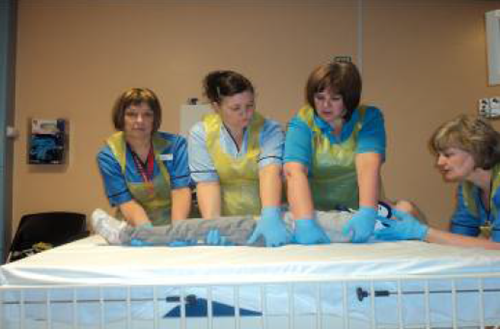
- Ensure that the bed is at the correct height for all team members (between hip and waist) to reduce excessive forward trunk flexion of the Team leader [Harrison 2000, 2015]
- Use a palm hold (indirect hold) to hold the child in the areas illustrated in the following photographs [MASCIP 2015].
- In preparation for this movement, get close to the bed, off set your feet and relax your knees slightly. It is good practice to stretch before and after the movement due to the static position you adopt in this movement.
- The child should be told what is happening even if he/she appears to be unconscious. The need for full exposure should be made clear but the child’s dignity must be maintained.
Positioning of hands is important and utilises natural skeletal landmarks for security of hold and patient comfort.
- The Team LEADER is at the head of the bed, and with fingers spread wide, slides both hands downwards either side of head so that the index finger rests below the jaw and remaining fingers support neck and occiput. As demonstrated in picture below.
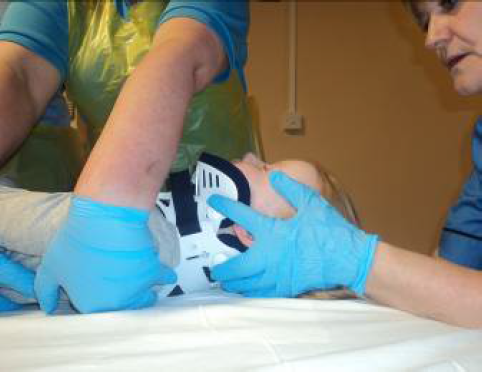

Assistant 1
Assistant 1 should be the tallest person in the team who places first hand on top shoulder and 2nd hand on top of hip (MASCIP 2015).
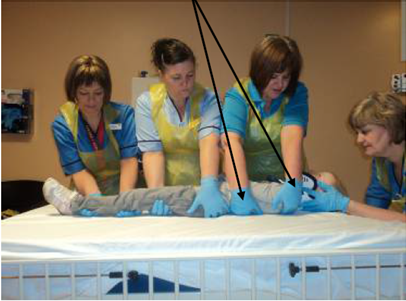
Assistant 2
Assistant 2 is responsible for ensuring that the lower spine is not twisted during the roll. He/she places 1st hand near the lower hand of Assistant 1 (on top at hip level) and 2nd hand under the furthest thigh (MASCIP 2015).

Assistant 3
Assistant 3 places 1st hand under the knee of the furthest leg and 2nd hand under the ankle of the same leg (MASCIP 2015).
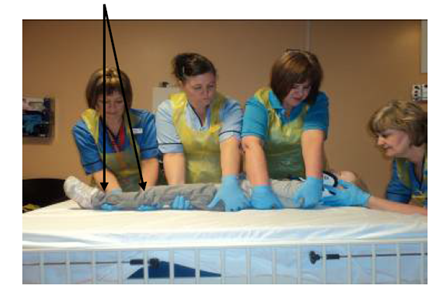
Airway and Hygiene assistant(s)
This person is responsible for maintaining the safety of lines and artificial airway during the roll. When the patient is balanced on their side, the ventilator tubing can be supported on the ventilator arm/other at which time skin assessment and hygiene needs can be attended to. The skin assessment should include skin under the collar (occiput)
In order to clarify timing of the log-roll, prior to any movement, the team leader should speak aloud instructions to move. For example, ‘1, 2, 3..Roll’.
- Following the log roll, the patient’s upper leg must be kept in alignment with the lower leg throughout the turn to prevent any flexion movement being relayed to the thoraco- lumbar spine
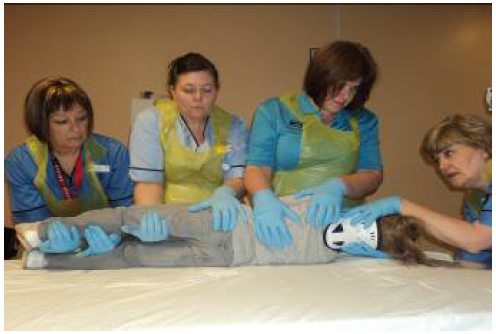
- Once, the procedure or care has been completed the team leader should again instruct the team to roll back. Again for example, "1, 2, 3...Roll"
At this point the Team Leader will instruct all assistants to remain where they are and will instruct them thus:
- Assistant 3 – should be first to remove their hands as well as ensuring the child’s legs remain steady once done
- Assistant 2 – should be the next to remove their hands
- Assistant 1 – should then remove their hands from the child.
All assistants should then wait until the team leader indicates no further assistance is required.
d. Team leader – should be the last to remove their hands, maintaining C-spine immobilization until child is secure.
As procedure for the child, with the following differences:
- The Team LEADER is at the head of the bed, and with fingers spread wide, slides both hands downwards either side of head so that the index finger rests below the jaw and remaining fingers support neck and occiput. As demonstrated in picture below.
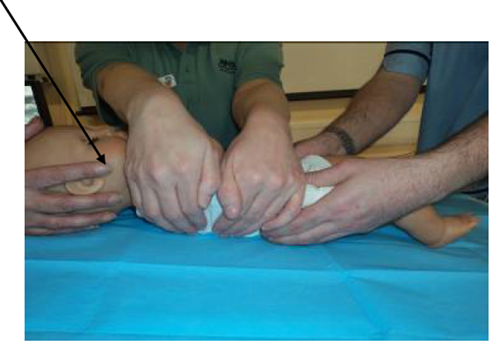
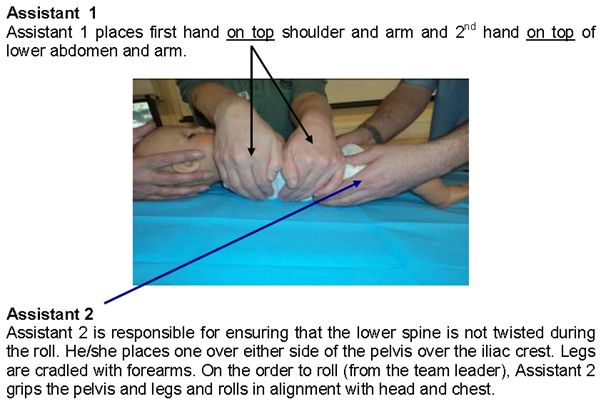
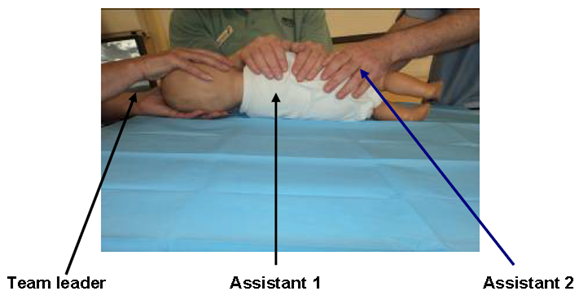
Once the procedure or care has been completed, the team leader should again instruct the team to roll back. Again for example ‘1, 2, 3…Roll’.
At this point the Team Leader will instruct all assistants to remain where they are and will instruct them thus:
- Assistant 2 – should be first to remove their hands as well as ensuring the child’s legs remain steady once done
- Assistant 1 – should then remove their hands from the child.
All assistants should then wait until the team leader indicates no further assistance is required.
c. Team leader – should be the last to remove their hands, maintaining C- spine immobilisation until infant is secure.
- Alder Hey (2011) Acute Paediatric Spinal Cord Injury (SCI) Guidelines: Based upon Burns (2005) PICU Guidelines. Produced by Alder Hey Children’s NHS Foundation Trust, Liverpool.
- APLS (2015) The structured approach to the seriously injured child. Advanced Life Support Group, Cambridge.
- Davidson, M Choudrey, V (2015) Trauma team triggers. Royal Hospital for Children, Glasgow.
- Davidson, M Choudrey, V (2018) Trauma team roles and responsibilities. Royal Hospital for Children, Glasgow.
- European Paediatric Advanced Life Support (2016) In-line cervical spine immobilisation. EPALS (4th Ed). Resuscitation Council, London.
- Harrison, P (2000) Managing spinal Injuries: critical care. The initial management of people with actual or suspected spinal cord injury in high dependency and intensive care units. Spinal Injuries Association.SIA:London.
-
Harrison, P ‘MASCIP’ (2015) “Moving and Handling Patients with Actual or Suspected Spinal cord Injuries”. Produced by the Spinal Cord Injury centres of the United Kingdom and Ireland.
- Meckler, G Leonard, J Hoyle, J (2014) Pediatric patient safety in emergency medical services. Semantic Scholar, Vol. 15 (1), pp. 18-27.
- RCEM. (2014) Handling the patient with spinal cord injury. The management of children with spinal cord injuries.
- RCH. (2017) Clinical guideline: Spinal cord injury (Acute management). The Royal Children’s Hospital, Melbourne.
- Walters, BC Hadley, MN Hurlbert, RJ Aarabi, B Dhall, SS Gelb, DE Harrigan, MR Rozelle, CJ Ryken, TC Theodore, N (2013) Guidelines for the Management of acute cervical spine and spinal cord injuries: 2013 update. Clinical Neurosurgery, Vol. 60, pp. 82-91.
- Warren, A Heward, Y (2010) PICU Guidelines: Cervical Spine Immobilisation. Produced by Birmingham Children’s Hospital NHS Trust, Birmingham.
Last reviewed: 01 April 2019
Next review: 31 March 2022
Author(s): Jeanette Grady
Approved By: Clinical Effectiveness
Reviewer Name(s): PICU Guideline group

